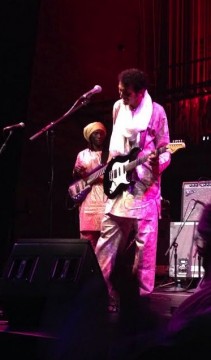
Nigerien guitarist Bombino performs at the Wexner Center for the Arts Sept. 10, 2014.
Credit: Sarah Mikati / Lantern reporter
Dedicated young adults, parents, grandparents and everyone in between waited in anticipation Wednesday night to watch internationally-acclaimed musician, Bombino, perform live at the Wexner Center for the Arts.
Bombino, whose real name is Omara Moctar, is a Tuareg tribe member from the northeast of Agadez, Niger — yet his music reaches far and wide. Columbus is just one of his many stops on a world tour scheduled for over a dozen more cities scattered across the United States and Europe.
A buzz of excitement circled around the Black Box on Mershon Stage before the show, the enthusiasm of the gathered crowd shining through their fascination with everything from the African and Latino influenced background music, to the gold light bulbs hanging from the ceiling (I actually watched multiple people drop their heads back and stare at the ceiling for a full minute).
Colored spotlights cast purple and blue soft hues on the stage, creating an intimate atmosphere in the Box.
Bombino and three other band members sauntered on stage, hands on heart, porting traditional Takatkat shirts made of a shiny fabric with intricate patterns in the stitching. Each member had a thick scarf casually draped around his neck. The outfits were contrasted with Western dress shoes, foreshadowing Bombino’s music and the rest of the concert.
The first song began with Bombino experimenting on his acoustic guitar, expertly picking at the strings with his long and slender fingers. The sound was soft and relaxing, yet energizing at the same time.
A climax began about halfway through, adding simple percussion with two African drums and foot stomps, then a simple vocal melody paired with a harmonica and finally the harmony vocals.
Each element of Bombino’s music focused on simplicity and tradition, with a raw and emotional sound that reached out to each member of the audience. The floor shook as people stomped their feet, and all around fans had their eyes closed as the movement of their bodies showed surrender to the music.
It was not only his music that connected to the crowd, but Bombino himself. Though he didn’t speak English, he attempted communication with his fluent French — towhich the crowd enthusiastically responded. And when a child in the crowd yelled out, “Koo koo!”, he responded with a crinkled smile, “Koo où?”
About four songs into the concert, everything flipped. Bombino and the second guitarist traded in their acoustic guitars for electric ones, while the bass player picked up an electric bass and the percussionist moved to the full drum set.
Enter Western sound.
Bombino continued introducing each song with his staple fingerpicking, however instead of a gradual climax, there was an explosion of all of the instrumentals at once.
The Western instruments carried traditional African sound through notes and melodies, while enhancing it with more sound, power and funk.
The songs were a mélange of Jimi Hendrix rock and your traditional African folk, and the audience loved it. Everywhere, people were head-banging, shimmying and doing the twist.
However, after a few of his Western-influenced songs, I found Bombino’s music to be rather redundant. Each song followed the same pattern: finger picking, eruption of loud instrumentals, end with an extended guitar solo.
Though Bombino’s songs are not distinct from one another, they are distinct from the rest of the music world.
Nearing the end of the concert, the second lead guitarist introduced one of Bombino’s songs, translated to “Greet My Country” in English. The first song of his first album, Bombino’s friend explained how Bombino had been traveling the world ever since it was released, greeting many countries along the way.
“Greet My Country” is the essential explanation of Bombino’s music. He has greeted a variety of countries, catering to his diverse audience with similarly diverse musical elements that reach out and connect to each fan’s background and homeland.


